镉(Cd)是环境中普遍存在的一种重金属,在水体、大气、土壤和食物等介质中广泛分布。镉不可生物降解[1-2],生物毒性强。国际癌症研究机构(IARC)[3-4]将镉列为第一类致癌物,世界卫生组织(WHO)将镉列为优先食物污染物。我国每年由工业废弃物排放到环境中的重金属镉总量高达680余t[5];世界环境范围内,镉化合物积累量超过22 000 t[6]。在健康风险评估中,镉是土壤-植物接触途径中最为关注的重金属之一,也是研究的主要污染物之一[7]。
通过饮食、呼吸和皮肤接触等途径,镉进入人体后,半衰期10~30年。非职业性镉暴露的健康危害主要表现为低剂量、长期接触和慢性中毒等特点[4],长期镉暴露会对人体的肾、肝、肺、骨骼、生殖系统及胚胎发育带来损伤,甚至致癌[8-11]。污染物的健康风险评价主要是通过风险评估模型估算污染物对人体健康危害的发生率,量化暴露于该有害因子的人群健康风险[12-14]。
本文针对镉的来源、形态、测定方法、分布特征、暴露途径及健康风险评价等方面的研究进展进行综述,以期为合理评估镉的健康风险提供科学依据,为镉暴露的健康风险防范和科学干预提供参考思路。
1 镉的来源(Source of cadmium)
1.1 环境中镉的来源
环境中镉主要分布在水体、大气和土壤中,不同介质中的镉分布有差异,来源也不同。表1列出不同环境介质中镉的来源。
表1 环境介质中镉的来源
Table 1 Sources of cadmium in environmental media

环境介质Environmental medium自然源Natural source人为源Man-made source水体Water body岩石风化、水动力作用、陆地径流、大气沉降等Rock weathering, hydrodynamic effects, land runoff, atmospheric subsidence, etc.工业废水(采矿、冶炼、颜料、电镀、塑料等行业)Industrial wastewater (mining, smelting, paint, electroplating, plastics, etc.)大气Atmosphere火山喷发、森林火灾、风生尘埃、海盐喷雾、生物源等Volcanic eruptions, forest fires, wind-generated dust, sea salt spray, biological sources, etc.工业废气(冶炼、燃煤、石油燃烧、垃圾焚烧、运输等)Industrial waste gas (smelting, coal burning, oil burning, garbage incineration, transportation, etc.)土壤Soil岩石、土壤本体Rock and soil body交通运输、农业活动、污水灌溉、污泥施肥、矿业活动Transportation, agricultural activities, sewage irrigation, sludge fertilization, mining activities
环境体系中镉的来源分自然源和人为源[15]。环境中镉的自然源主要包括火山、矿物风化等自然活动;水体中镉的自然源为岩石风化、水动力作用、陆地径流和大气沉降等;大气中镉的自然源为火山喷发、森林火灾、风生尘埃、海盐喷雾和生物源等;土壤中镉的自然源为岩石、土壤本体。
人为来源的镉是造成环境中镉污染的主要原因,环境中镉的人为源主要包括:(1)矿物元素的开采:伴随着不同金属元素的开采,重金属镉释放到环境中;(2)工农业原料的使用:含镉材料在电镀、杀虫以及防腐等行业的使用过程进入环境中[16]。水体中镉主要来源于工业废水(采矿、冶炼、颜料、电镀和塑料等行业)的排放;大气中镉主要来源于工业废气(冶炼、燃煤、石油燃烧、垃圾焚烧和运输等)的排放;土壤中镉主要来源于交通运输、农业活动、污水灌溉、污泥施肥和矿业活动等。
1.2 食品中镉的来源
镉迁移性强,工业生产及生活活动排放的含镉废水、废气、废渣,经作物吸收、食物链或接触吸附等方式进入到食品中,成为食品中镉的来源[17]。
农作物的根系易从土壤中吸收并富集镉;农业上施用含镉农药或化肥,使镉进入土壤蓄积,进而被作物吸收。
养殖水体中含镉,经非生物作用使得水产品富集镉;畜牧业使用的饲料、药物等含镉,造成畜禽体内积累镉。
在包装或盛装食品时,使用由合金、釉彩和颜料等含镉材料,析出的微量镉沾染在食品上,致使食品被镉污染。
2 镉的形态(Forms of cadmium)
2.1 大气颗粒物中镉的形态
大气颗粒物中重金属形态常分为4种:可溶态与可交换态(F1);可氧化态与可还原态、碳酸盐态(F2);有机质、氧化物与硫化物结合态(F3);残渣态(F4) [18]。大气颗粒物中镉以CdCl2、CdSO4、CdS、CdO和CdSe等形式存在,主要来源是工业废气、化石燃料燃烧烟气和机动车尾气。
当前,常采用BCR法和Tisser法对重金属形态进行提取。顾佳丽等[19]采用改进的BCR提取法,发现大气颗粒物中镉主要以酸可提取态(F1)、氧化物结合态(F2)2种形态存在;陆喜红等[20]通过BCR法,发现大气颗粒物中镉主要以弱酸提取态存在。镉在大气颗粒物中的形态不同,其生物有效性及毒性也会不同,F1、F2这2种形态易发生迁移转化,对人体以及环境具有很大危害。
2.2 水环境中镉的形态
水体中镉的形态主要分为2类:溶解态(<0.45 μm)和非溶解态(沉积物、颗粒态和悬浮态)(>0.45 μm)[21]。溶解态镉主要以Cd2+形式存在[22]。水环境中镉的毒性主要以Cd2+含量为据。水体中Cd2+可与![]() 和
和![]() 等生成络合物,生成的络合物可形成沉淀物或转变为无毒性的物质,稳定性强。非溶解态的镉存在可交换态、碳酸盐态以及残渣态等形态的镉,可与大气颗粒物中镉形态对应,除残渣态外,其他形态镉易发生迁移转化,从而危害环境以及人体健康。
等生成络合物,生成的络合物可形成沉淀物或转变为无毒性的物质,稳定性强。非溶解态的镉存在可交换态、碳酸盐态以及残渣态等形态的镉,可与大气颗粒物中镉形态对应,除残渣态外,其他形态镉易发生迁移转化,从而危害环境以及人体健康。
2.3 土壤中镉的形态
土壤中镉的形态与大气颗粒物中4种镉形态分类一致。土壤中可溶态镉常以简单离子或简单配离子的形式存在,如Cd2+、CdCl+和CdSO4,石灰性土壤中还有![]() 形式镉,其他形式镉
形式镉,其他形式镉![]() 及有机配合物等)少见。非水溶性镉主要以CdS、CdCO3及胶体吸附的形式存在[23]。
及有机配合物等)少见。非水溶性镉主要以CdS、CdCO3及胶体吸附的形式存在[23]。
旱地中,镉多以难溶性CdCO3、Cd3(PO4)2和Cd(OH)2的形式存在,而在水田中,则多以CdS的形式存在。
土壤中镉的形态会受土壤理化性质(pH值、有机质和土壤粒度等)影响。张鑫等[24]研究发现铜陵矿区表层土壤中镉的形态与土壤酸碱度有关,酸性土壤中镉以铁锰氧化态、可交换态为主,有机态、残渣态、碳酸盐态较少;碱性土壤中镉有机态、残渣态较多,碳酸盐态、可交换态较少。龚媛媛等[25]研究燃煤型氟中毒地区土壤镉形态,发现区域土壤中镉的形态分布特征为:可氧化态>弱酸提取态>可还原态>水溶态>残渣态,土壤镉生物有效性高,主要与富镉的黑色泥页岩、碳质粉砂岩和煤层的风化有关。钟志淋等[26]研究三峡库区不同高层土壤镉形态,发现区域土壤镉主要以可交换态、碳酸盐结合态存在,主要与土壤粒度组成有关。
3 镉的检测(Cadmium detection)
3.1 样品前处理方法
样品前处理工作对检测结果的准确性非常重要,样品中镉检测的前处理方法汇总如表2所示。当前,样品中镉检测的前处理方法以湿法消解、微波消解最为常用,其中微波消解因其消解时间短、精确度和准确度好、易于操作、空白值低等特点,应用最为广泛。
表2 样品中镉检测的前处理方法
Table 2 Pretreatment method for detection of cadmium in samples
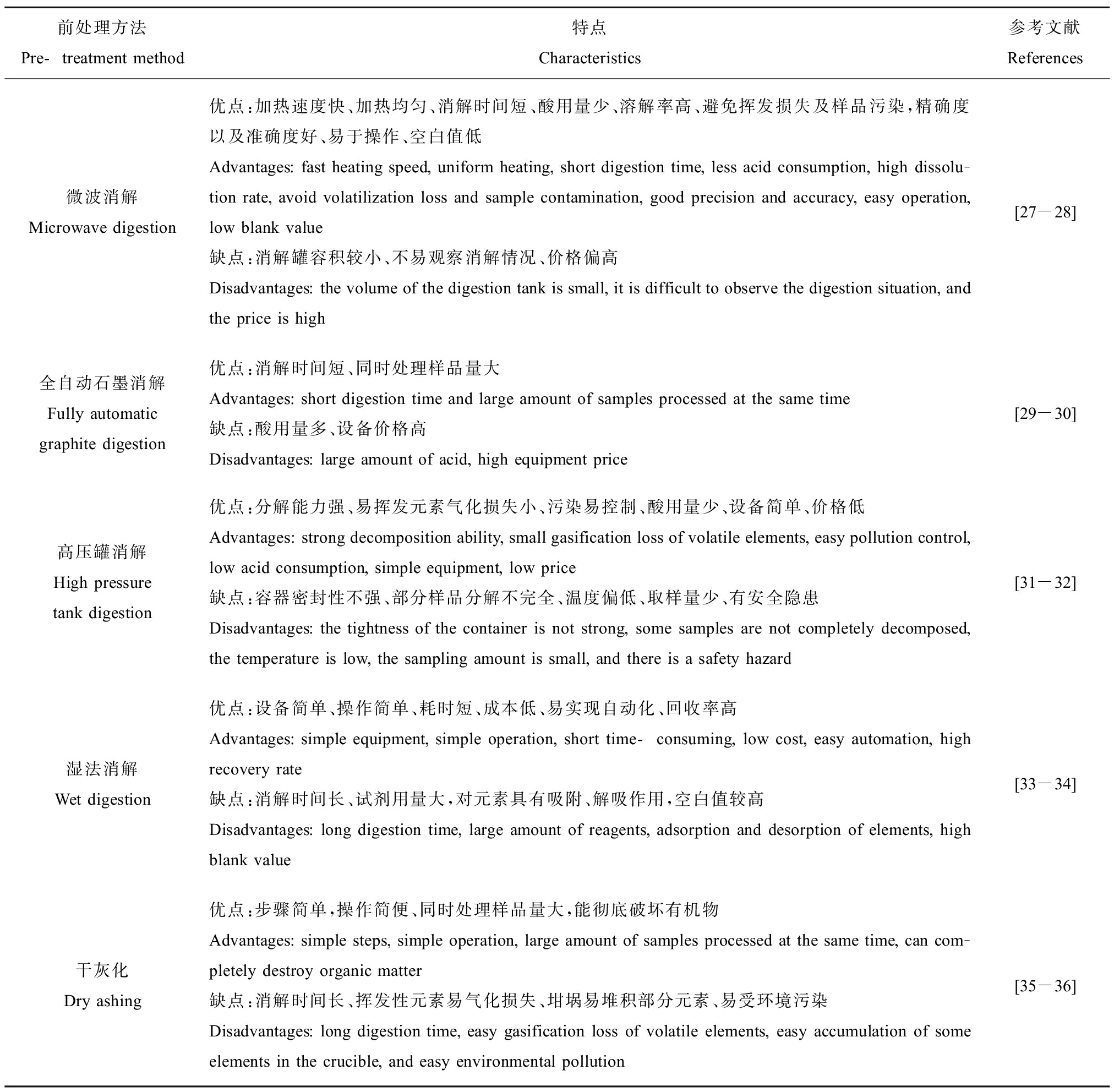
前处理方法Pre-treatment method特点Characteristics参考文献References微波消解Microwave digestion优点:加热速度快、加热均匀、消解时间短、酸用量少、溶解率高、避免挥发损失及样品污染,精确度以及准确度好、易于操作、空白值低Advantages: fast heating speed, uniform heating, short digestion time, less acid consumption, high dissolu-tion rate, avoid volatilization loss and sample contamination, good precision and accuracy, easy operation, low blank value缺点:消解罐容积较小、不易观察消解情况、价格偏高Disadvantages: the volume of the digestion tank is small, it is difficult to observe the digestion situation, and the price is high[27-28]全自动石墨消解Fully automatic graphite digestion优点:消解时间短、同时处理样品量大Advantages: short digestion time and large amount of samples processed at the same time缺点:酸用量多、设备价格高Disadvantages: large amount of acid, high equipment price[29-30]高压罐消解High pressure tank digestion优点:分解能力强、易挥发元素气化损失小、污染易控制、酸用量少、设备简单、价格低Advantages: strong decomposition ability, small gasification loss of volatile elements, easy pollution control, low acid consumption, simple equipment, low price缺点:容器密封性不强、部分样品分解不完全、温度偏低、取样量少、有安全隐患Disadvantages: the tightness of the container is not strong, some samples are not completely decomposed, the temperature is low, the sampling amount is small, and there is a safety hazard[31-32]湿法消解Wet digestion优点:设备简单、操作简单、耗时短、成本低、易实现自动化、回收率高Advantages: simple equipment, simple operation, short time-consuming, low cost, easy automation, high recovery rate缺点:消解时间长、试剂用量大,对元素具有吸附、解吸作用,空白值较高Disadvantages: long digestion time, large amount of reagents, adsorption and desorption of elements, high blank value[33-34]干灰化Dry ashing优点:步骤简单,操作简便、同时处理样品量大,能彻底破坏有机物Advantages: simple steps, simple operation, large amount of samples processed at the same time, can com-pletely destroy organic matter缺点:消解时间长、挥发性元素易气化损失、坩埚易堆积部分元素、易受环境污染Disadvantages: long digestion time, easy gasification loss of volatile elements, easy accumulation of some elements in the crucible, and easy environmental pollution[35-36]
3.2 镉形态的提取
重金属化学形态分析采用连续化学浸提,目前常用的镉形态提取法包括:Tessier五步浸提法、BCR三步浸提法和改进版BCR浸提法。不同浸提法的操作步骤如表3所示。
表3所列的镉形态提取方法中,改进版BCR浸提法重现性好,提取精度较高,并且其数据具有可比性,有标准参考物,因而在国际上通用,应用最为广泛。
表3 不同浸提法对镉形态提取的操作步骤
Table 3 Operation steps of different extraction methods for cadmium species extraction
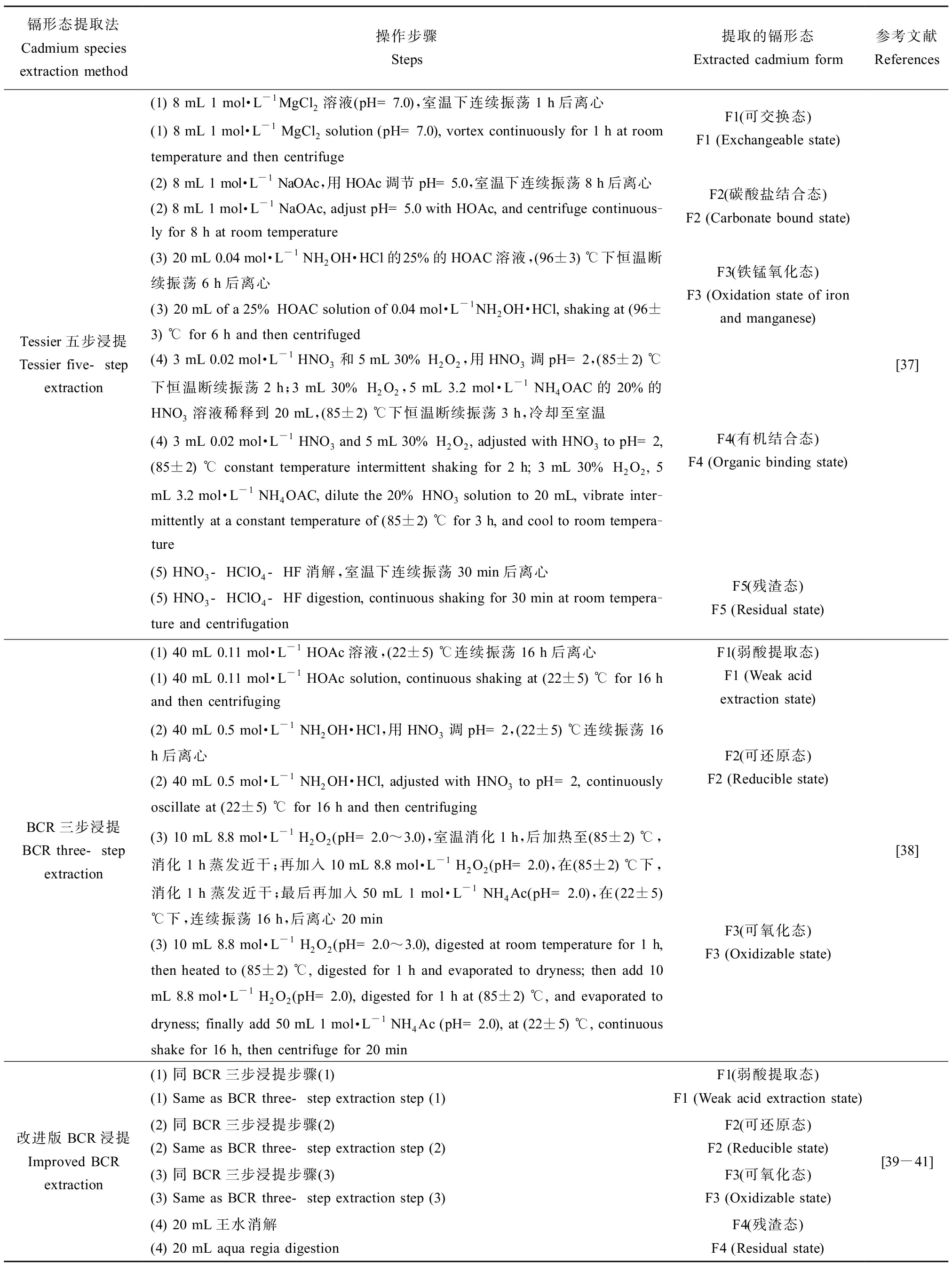
镉形态提取法Cadmium species extraction method操作步骤Steps提取的镉形态Extracted cadmium form参考文献ReferencesTessier五步浸提Tessier five-step extraction(1) 8 mL 1 mol·L-1MgCl2溶液(pH=7.0),室温下连续振荡1 h后离心(1) 8 mL 1 mol·L-1 MgCl2 solution (pH=7.0), vortex continuously for 1 h at room temperature and then centrifugeF1(可交换态)F1 (Exchangeable state)(2) 8 mL 1 mol·L-1 NaOAc,用HOAc调节pH=5.0,室温下连续振荡8 h后离心(2) 8 mL 1 mol·L-1 NaOAc, adjust pH=5.0 with HOAc, and centrifuge continuous-ly for 8 h at room temperatureF2(碳酸盐结合态)F2 (Carbonate bound state)(3) 20 mL 0.04 mol·L-1 NH2OH·HCl的25%的HOAC溶液,(96±3) ℃下恒温断续振荡6 h后离心(3) 20 mL of a 25% HOAC solution of 0.04 mol·L-1NH2OH·HCl, shaking at (96±3) ℃ for 6 h and then centrifugedF3(铁锰氧化态)F3 (Oxidation state of iron and manganese)(4) 3 mL 0.02 mol·L-1 HNO3和5 mL 30% H2O2,用HNO3调pH=2,(85±2) ℃下恒温断续振荡2 h;3 mL 30% H2O2,5 mL 3.2 mol·L-1 NH4OAC的20%的HNO3溶液稀释到20 mL,(85±2) ℃下恒温断续振荡3 h,冷却至室温(4) 3 mL 0.02 mol·L-1 HNO3 and 5 mL 30% H2O2, adjusted with HNO3 to pH=2, (85±2) ℃ constant temperature intermittent shaking for 2 h; 3 mL 30% H2O2, 5 mL 3.2 mol·L-1 NH4OAC, dilute the 20% HNO3 solution to 20 mL, vibrate inter-mittently at a constant temperature of (85±2) ℃ for 3 h, and cool to room tempera-tureF4(有机结合态)F4 (Organic binding state)(5) HNO3-HClO4-HF消解,室温下连续振荡30 min后离心(5) HNO3-HClO4-HF digestion, continuous shaking for 30 min at room tempera-ture and centrifugationF5(残渣态)F5 (Residual state)[37]BCR三步浸提BCR three-step extraction(1) 40 mL 0.11 mol·L-1 HOAc溶液,(22±5) ℃连续振荡16 h后离心(1) 40 mL 0.11 mol·L-1 HOAc solution, continuous shaking at (22±5) ℃ for 16 h and then centrifugingF1(弱酸提取态)F1 (Weak acid extraction state)(2) 40 mL 0.5 mol·L-1 NH2OH·HCl,用HNO3调pH=2,(22±5) ℃连续振荡16 h后离心(2) 40 mL 0.5 mol·L-1 NH2OH·HCl, adjusted with HNO3 to pH=2, continuously oscillate at (22±5) ℃ for 16 h and then centrifugingF2(可还原态)F2 (Reducible state)(3) 10 mL 8.8 mol·L-1 H2O2(pH=2.0~3.0),室温消化1 h,后加热至(85±2) ℃,消化1 h蒸发近干;再加入10 mL 8.8 mol·L-1 H2O2(pH=2.0),在(85±2) ℃下,消化1 h 蒸发近干;最后再加入50 mL 1 mol·L-1 NH4Ac(pH=2.0),在(22±5) ℃下,连续振荡16 h,后离心20 min(3) 10 mL 8.8 mol·L-1 H2O2 (pH=2.0~3.0), digested at room temperature for 1 h, then heated to (85±2) ℃, digested for 1 h and evaporated to dryness; then add 10 mL 8.8 mol·L-1 H2O2 (pH=2.0), digested for 1 h at (85±2) ℃, and evaporated to dryness; finally add 50 mL 1 mol·L-1 NH4Ac (pH=2.0), at (22±5) ℃, continuous shake for 16 h, then centrifuge for 20 minF3(可氧化态)F3 (Oxidizable state)[38]改进版BCR浸提Improved BCR extraction(1) 同BCR三步浸提步骤(1)(1) Same as BCR three-step extraction step (1)F1(弱酸提取态)F1 (Weak acid extraction state)(2) 同BCR三步浸提步骤(2)(2) Same as BCR three-step extraction step (2)F2(可还原态)F2 (Reducible state)(3) 同BCR三步浸提步骤(3)(3) Same as BCR three-step extraction step (3)F3(可氧化态)F3 (Oxidizable state)(4) 20 mL王水消解(4) 20 mL aqua regia digestionF4(残渣态)F4 (Residual state)[39-41]
3.3 镉的检测方法
样品中镉检测常用方法汇总如表4所示。目前常用的镉的检测方法有:电感耦合等离子体原子发射光谱法、电感耦合等离子体质谱法和原子荧光光谱法等,其中原子荧光光谱法适于检测具有挥发性的镉;石墨炉原子吸收光谱法(GFAAS)具有检出限低、准确度好的优点,但缺点是重现性和精密度较差。ICP-MS和GFAAS可检测出μg·L-1的镉浓度,广泛运用于镉的测定。具体选取何种检测方法,与镉的浓度、形态有关,应根据样品的类型以及相应的国家标准方法、实验室现有仪器条件以及测定成本来考虑。
表4 样品中镉的检测方法
Table 4 Method for detecting cadmium in samples
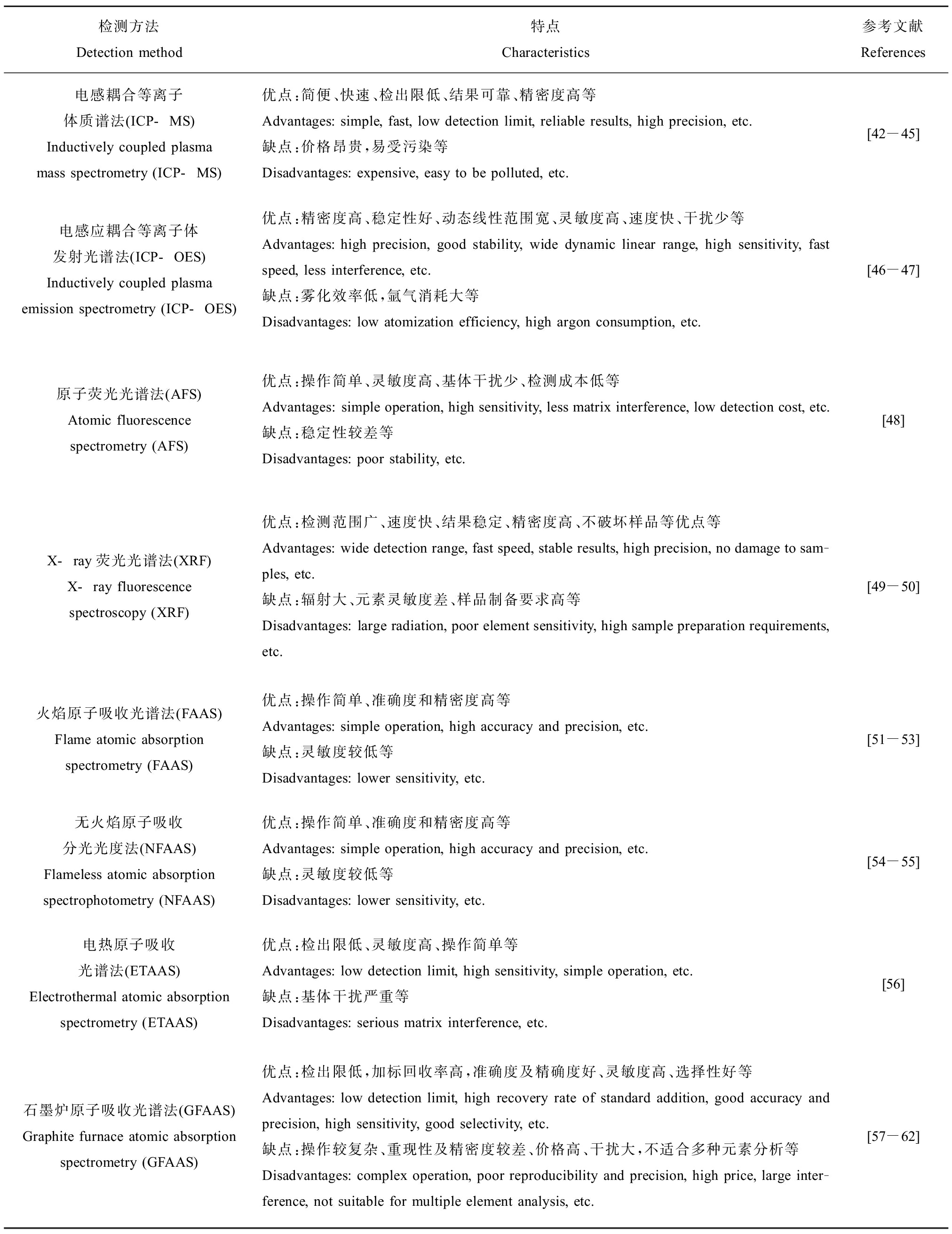
检测方法Detection method特点Characteristics参考文献References电感耦合等离子体质谱法(ICP-MS)Inductively coupled plasma mass spectrometry (ICP-MS)优点:简便、快速、检出限低、结果可靠、精密度高等Advantages: simple, fast, low detection limit, reliable results, high precision, etc.缺点:价格昂贵,易受污染等Disadvantages: expensive, easy to be polluted, etc.[42-45]电感应耦合等离子体发射光谱法(ICP-OES)Inductively coupled plasma emission spectrometry (ICP-OES)优点:精密度高、稳定性好、动态线性范围宽、灵敏度高、速度快、干扰少等Advantages: high precision, good stability, wide dynamic linear range, high sensitivity, fast speed, less interference, etc.缺点:雾化效率低,氩气消耗大等Disadvantages: low atomization efficiency, high argon consumption, etc.[46-47]原子荧光光谱法(AFS)Atomic fluorescence spectrometry (AFS)优点:操作简单、灵敏度高、基体干扰少、检测成本低等Advantages: simple operation, high sensitivity, less matrix interference, low detection cost, etc.缺点:稳定性较差等Disadvantages: poor stability, etc.[48]X-ray荧光光谱法(XRF)X-ray fluorescence spectroscopy (XRF)优点:检测范围广、速度快、结果稳定、精密度高、不破坏样品等优点等Advantages: wide detection range, fast speed, stable results, high precision, no damage to sam-ples, etc.缺点:辐射大、元素灵敏度差、样品制备要求高等Disadvantages: large radiation, poor element sensitivity, high sample preparation requirements, etc.[49-50]火焰原子吸收光谱法(FAAS)Flame atomic absorption spectrometry (FAAS)优点:操作简单、准确度和精密度高等Advantages: simple operation, high accuracy and precision, etc.缺点:灵敏度较低等Disadvantages: lower sensitivity, etc.[51-53]无火焰原子吸收分光光度法(NFAAS)Flameless atomic absorption spectrophotometry (NFAAS)优点:操作简单、准确度和精密度高等Advantages: simple operation, high accuracy and precision, etc.缺点:灵敏度较低等Disadvantages: lower sensitivity, etc.[54-55]电热原子吸收光谱法(ETAAS)Electrothermal atomic absorption spectrometry (ETAAS)优点:检出限低、灵敏度高、操作简单等Advantages: low detection limit, high sensitivity, simple operation, etc.缺点:基体干扰严重等Disadvantages: serious matrix interference, etc.[56]石墨炉原子吸收光谱法(GFAAS)Graphite furnace atomic absorption spectrometry (GFAAS)优点:检出限低,加标回收率高,准确度及精确度好、灵敏度高、选择性好等Advantages: low detection limit, high recovery rate of standard addition, good accuracy and precision, high sensitivity, good selectivity, etc.缺点:操作较复杂、重现性及精密度较差、价格高、干扰大,不适合多种元素分析等Disadvantages: complex operation, poor reproducibility and precision, high price, large inter-ference, not suitable for multiple element analysis, etc.[57-62]
4 镉在不同介质中的分布(Distribution of cadmium in different media)
4.1 大气环境中镉的分布
表5中列出文献报道的国内外部分研究区域大气颗粒物中镉的分布。由表5可知,不同季节、不同区域的大气环境中镉的浓度分布有差异,现有文献关于大气环境中镉分布的研究主要集中于北京、上海和南京等大城市,国内多个城市大气颗粒物中镉的浓度高于《环境空气质量标准》(GB 3095—2012)[72]和WHO的空气质量标准[73]中5 ng·m-3的限值。相比国外许多区域,中国一些城市区域大气颗粒物中镉浓度较高,镉污染问题及相应的人群健康风险须引起重视。
表5 大气颗粒物中镉的浓度分布
Table 5 Concentration distribution of cadmium in atmospheric particulates
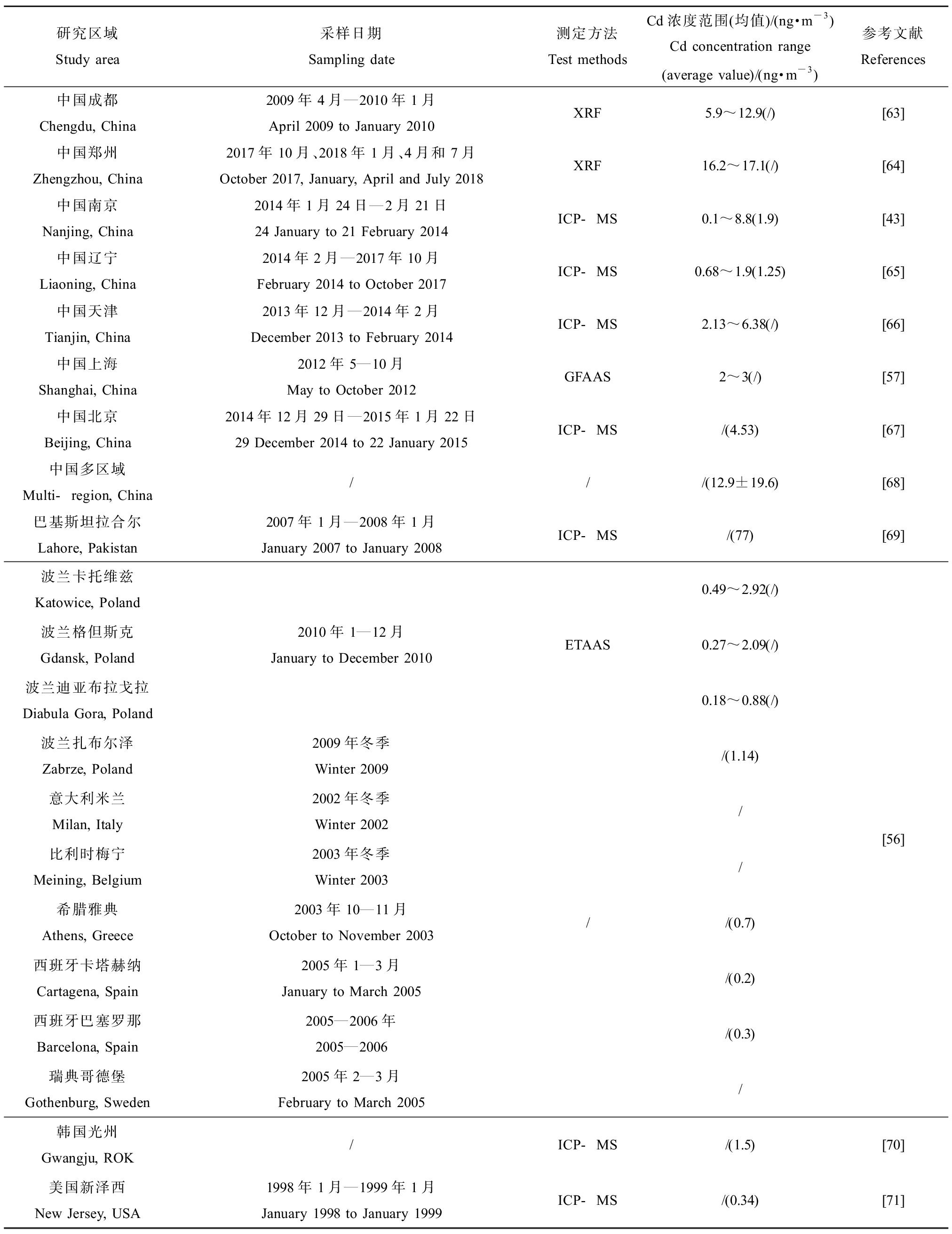
研究区域Study area采样日期Sampling date测定方法Test methodsCd浓度范围(均值)/(ng·m-3)Cd concentration range (average value)/(ng·m-3)参考文献References中国成都Chengdu, China2009年4月—2010年1月April 2009 to January 2010XRF5.9~12.9(/)[63]中国郑州Zhengzhou, China2017年10月、2018年1月、4月和7月October 2017, January, April and July 2018XRF16.2~17.1(/)[64]中国南京Nanjing, China2014年1月24日—2月21日24 January to 21 February 2014ICP-MS0.1~8.8(1.9)[43]中国辽宁Liaoning, China2014年2月—2017年10月February 2014 to October 2017ICP-MS0.68~1.9(1.25)[65]中国天津Tianjin, China2013年12月—2014年2月December 2013 to February 2014ICP-MS2.13~6.38(/)[66]中国上海Shanghai, China2012年5—10月May to October 2012GFAAS2~3(/)[57]中国北京Beijing, China2014年12月29日—2015年1月22日29 December 2014 to 22 January 2015ICP-MS/(4.53)[67]中国多区域Multi-region, China///(12.9±19.6)[68]巴基斯坦拉合尔Lahore, Pakistan2007年1月—2008年1月January 2007 to January 2008ICP-MS/(77)[69]波兰卡托维兹Katowice, Poland波兰格但斯克Gdansk, Poland 波兰迪亚布拉戈拉Diabula Gora, Poland波兰扎布尔泽Zabrze, Poland意大利米兰Milan, Italy比利时梅宁Meining, Belgium希腊雅典Athens, Greece西班牙卡塔赫纳Cartagena, Spain西班牙巴塞罗那Barcelona, Spain瑞典哥德堡Gothenburg, Sweden2010年1—12月January to December 20102009年冬季Winter 20092002年冬季Winter 20022003年冬季Winter 20032003年10—11月October to November 20032005年1—3月January to March 20052005—2006年2005—20062005年2—3月February to March 2005ETAAS/0.49~2.92(/)0.27~2.09(/)0.18~0.88(/)/(1.14)///(0.7)/(0.2)/(0.3)/[56]韩国光州Gwangju, ROK/ICP-MS/(1.5)[70]美国新泽西New Jersey, USA1998年1月—1999年1月January 1998 to January 1999ICP-MS/(0.34)[71]
注:/表示该文章未注明。
Note: / means that the data is not noted in the article.
4.2 饮用水中镉的分布
表6列出现有文献报道的国内外部分区域饮用水中镉的分布。我国卫生部颁布的《生活饮用水卫生标准》(GB 5749—2006)[78]规定,生活用水中镉含量不应超过0.005 mg·L-1。国际上饮用水镉含量标准:美国环境保护局(US EPA)[79] 5 μg·L-1;WHO[80]3 μg·L-1。由表6可知,文献报道中我国部分城市水体中镉含量未超过我国生活饮用水的限值标准,而孟加拉国东南沿海、巴基斯坦北部科希斯坦地区、埃及阿苏特市水体超出了WHO饮用水镉含量标准。
表6 饮用水中镉的浓度分布
Table 6 Concentration distribution of cadmium in drinking water
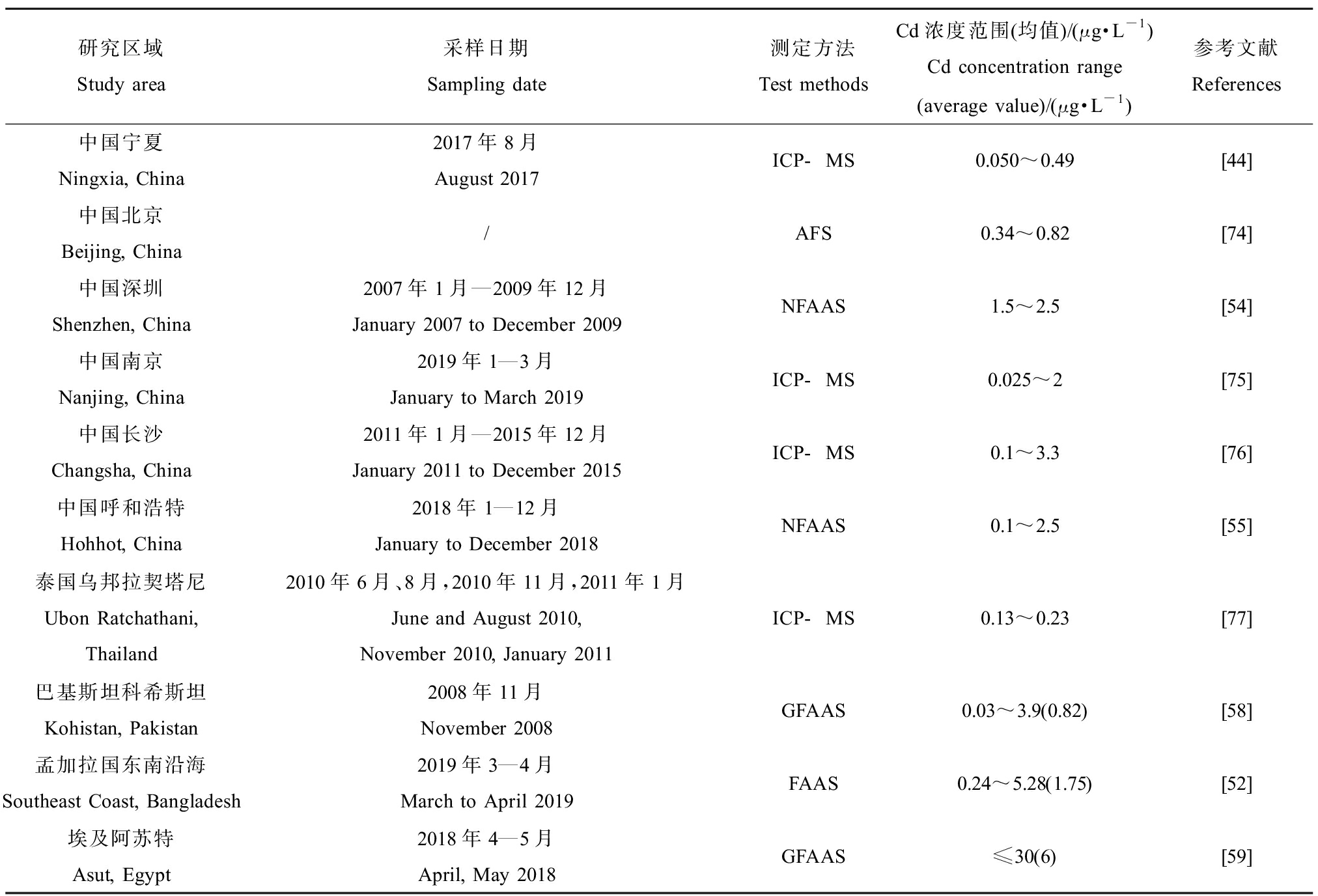
研究区域Study area采样日期Sampling date测定方法Test methodsCd浓度范围(均值)/(μg·L-1)Cd concentration range (average value)/(μg·L-1)参考文献References中国宁夏Ningxia, China2017年8月August 2017ICP-MS0.050~0.49[44]中国北京Beijing, China/AFS0.34~0.82[74]中国深圳Shenzhen, China2007年1月—2009年12月January 2007 to December 2009NFAAS1.5~2.5[54]中国南京Nanjing, China2019年1—3月January to March 2019ICP-MS0.025~2[75]中国长沙Changsha, China2011年1月—2015年12月January 2011 to December 2015ICP-MS0.1~3.3[76]中国呼和浩特Hohhot, China2018年1—12月January to December 2018NFAAS0.1~2.5[55]泰国乌邦拉契塔尼Ubon Ratchathani, Thailand2010年6月、8月,2010年11月,2011年1月June and August 2010, November 2010, January 2011ICP-MS0.13~0.23[77]巴基斯坦科希斯坦Kohistan, Pakistan2008年11月November 2008GFAAS0.03~3.9(0.82)[58]孟加拉国东南沿海Southeast Coast, Bangladesh2019年3—4月March to April 2019FAAS0.24~5.28(1.75)[52]埃及阿苏特Asut, Egypt2018年4—5月April, May 2018GFAAS≤30(6)[59]
注:/表示该文章未注明。
Note: :/ means that the data is not noted in the article.
4.3 土壤中镉的分布
《中国农田和城市土壤重金属现场监测试验研究报告》(2000—2019年)[81]指出,我国土壤中镉的平均浓度为0.19 mg·kg-1,与土壤镉背景值(0.097 mg·kg-1)相比,农田土壤镉含量增加了1倍(0.19 mg·kg-1),城市土壤镉含量增加了2倍(0.29 mg·kg-1)。
4.3.1 农田土壤中镉的分布
表7列出国内外部分研究区域农田土壤中镉的分布。由表7可知,几乎所有研究区域土壤中镉的浓度都超过了当地的土壤背景值,其中贵州省雷山、河北省石家庄、陕西省潼关县、天津市土壤中镉的浓度都有一定程度超过土壤环境质量农用地土壤污染风险管控标准(GB 15618—2018)[87]中的标准限值。
表7 农田土壤中镉的浓度分布
Table 7 Concentration distribution of cadmium in farmland soil
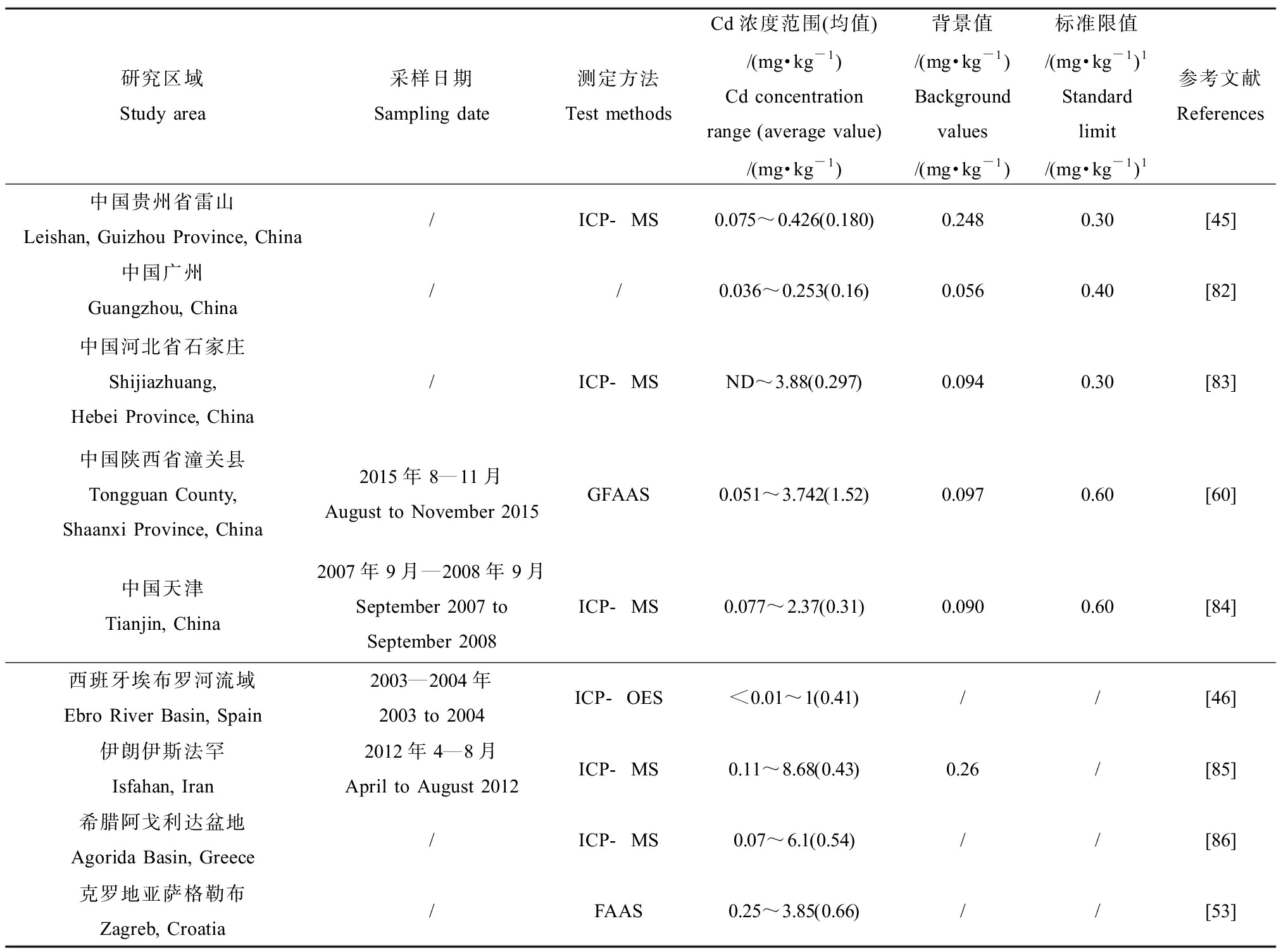
研究区域Study area采样日期Sampling date测定方法Test methodsCd浓度范围(均值)/(mg·kg-1)Cd concentration range (average value)/(mg·kg-1)背景值/(mg·kg-1)Background values/(mg·kg-1)标准限值/(mg·kg-1)1Standard limit/(mg·kg-1)1参考文献References中国贵州省雷山Leishan, Guizhou Province, China/ICP-MS0.075~0.426(0.180)0.2480.30[45]中国广州Guangzhou, China//0.036~0.253(0.16)0.0560.40[82]中国河北省石家庄Shijiazhuang, Hebei Province, China/ICP-MSND~3.88(0.297)0.0940.30[83]中国陕西省潼关县Tongguan County, Shaanxi Province, China2015年8—11月August to November 2015GFAAS0.051~3.742(1.52)0.0970.60[60]中国天津Tianjin, China2007年9月—2008年9月September 2007 to September 2008ICP-MS0.077~2.37(0.31)0.0900.60[84]西班牙埃布罗河流域Ebro River Basin, Spain2003—2004年2003 to 2004ICP-OES<0.01~1(0.41)//[46]伊朗伊斯法罕Isfahan, Iran2012年4—8月April to August 2012ICP-MS0.11~8.68(0.43)0.26/[85]希腊阿戈利达盆地Agorida Basin, Greece/ICP-MS0.07~6.1(0.54)//[86]克罗地亚萨格勒布Zagreb, Croatia/FAAS0.25~3.85(0.66)//[53]
注:/表示该文章未注明,1农用地土壤污染风险筛选值(GB 15618—2018)二级标准值[87];ND表示未检出。
Note: / means that the data is not noted in the article; 1 secondary standard value of agricultural land soil pollution risk screening value (GB 15618—2018) [87]; ND means not detected.
4.3.2 城市土壤中镉的分布
表8列出国内外部分城市非农田土壤中镉的含量。由表8可知,表中几乎所有城市土壤中镉的浓度都超过了当地的土壤背景值,城市区域非农田土壤都有不同程度的镉污染。其中重庆(中国)、石家庄(中国)、武汉(中国)、斯法罕(伊朗)和梅达克(印度)区域的土壤重度镉污染;商丘(中国)、埃尔比勒(伊拉克)区域的土壤中度镉污染。
表8 城市非农田土壤中镉的浓度分布
Table 8 Concentration distribution of cadmium in urban non-agricultural soil

研究区域Study area采样日期Sampling date测定方法Test methodsCd浓度范围(均值)/(mg·kg-1)Cd concentration range (average value)/(mg·kg-1)背景值/(mg·kg-1)Background values/(mg·kg-1)平均超标倍数(Pi)/(平均值/背景值)bAverage exceeding multiple (Pi)/(average value/background value) b参考文献References中国商丘Shangqiu, China/ICP-MS0.091~2.448(0.278)0.1032.70[88]中国太原Taiyuan, China2006年3—4月March to April 2006GFAAS/(0.208)0.1121.85[89]中国重庆Chongqing, China/XRF0.073~0.858(0.279)0.0793.53[90]中国石家庄Shijiazhuang, China/GFAAS0.125~5.22(0.275)0.153.48[61]中国哈尔滨Harbin, China2008年10月October 2008GFAAS0.07~0.25(0.1264)//[91]中国武汉Wuhan, China//0.3~4.55(1.73)0.1710.17[92]伊朗斯法罕Sfahan, Iran2011年7月July 2011ICP-MS0.25~74.72(2.17)0.425.16[93]伊拉克埃尔比勒Erbil, Iraq/ICP-OES0.1~3.25(1.03)0.352.94[47]意大利科森扎-仁德Cosenza-Rende, Italy/ICP-MS0.13~2.44(0.4)//[94]印度梅达克Medak, India/XRF0.1~4.2(1.073)0.1a10.73[50]
注:/表示该文章未注明;a 地球化学背景值;b 平均超标倍数(Pi),Pi≤1(无污染),1<Pi≤2(轻度污染),2<Pi≤3(中度污染),Pi>3(重度污染)。
Note: / means that the data is not noted in the article; a geochemical background value; b the average excess multiple (Pi), Pi≤1 (no pollution), 1<Pi≤2 (light pollution), 2<Pi≤3 (medium pollution), Pi>3 (severe pollution).
4.4 食品中镉的分布
表9列出我国部分城市不同食品种类中镉的含量。膳食摄入是镉进入人体的主要途径[104]。在人类膳食中,镉的浓度常受食物种类以及环境污染程度的影响。农作物中镉含量比肉类、蛋、牛奶、乳制品和鱼类中的高。农作物产品中,谷物(大米、小麦等)、根茎类蔬菜(绿叶蔬菜、土豆等)镉含量常高于其他农作物产品中的镉[105]。由表9可知,部分区域大米中镉浓度高于其他食品种类,文献中报道的杭州以及湘潭地区大米中镉的含量超出《食品安全国家标准 食品中污染物限量》(GB 2762—2017) [103]中规定的0.2 mg·kg-1;镉在贝类中的浓度相对高于其他类水产品中的,深圳市贝类镉浓度最高,平均浓度达到1.439 mg·kg-1。
表9 我国部分区域食品不同种类镉的浓度
Table 9 Concentrations of different types of cadmium in foods in some regions of China
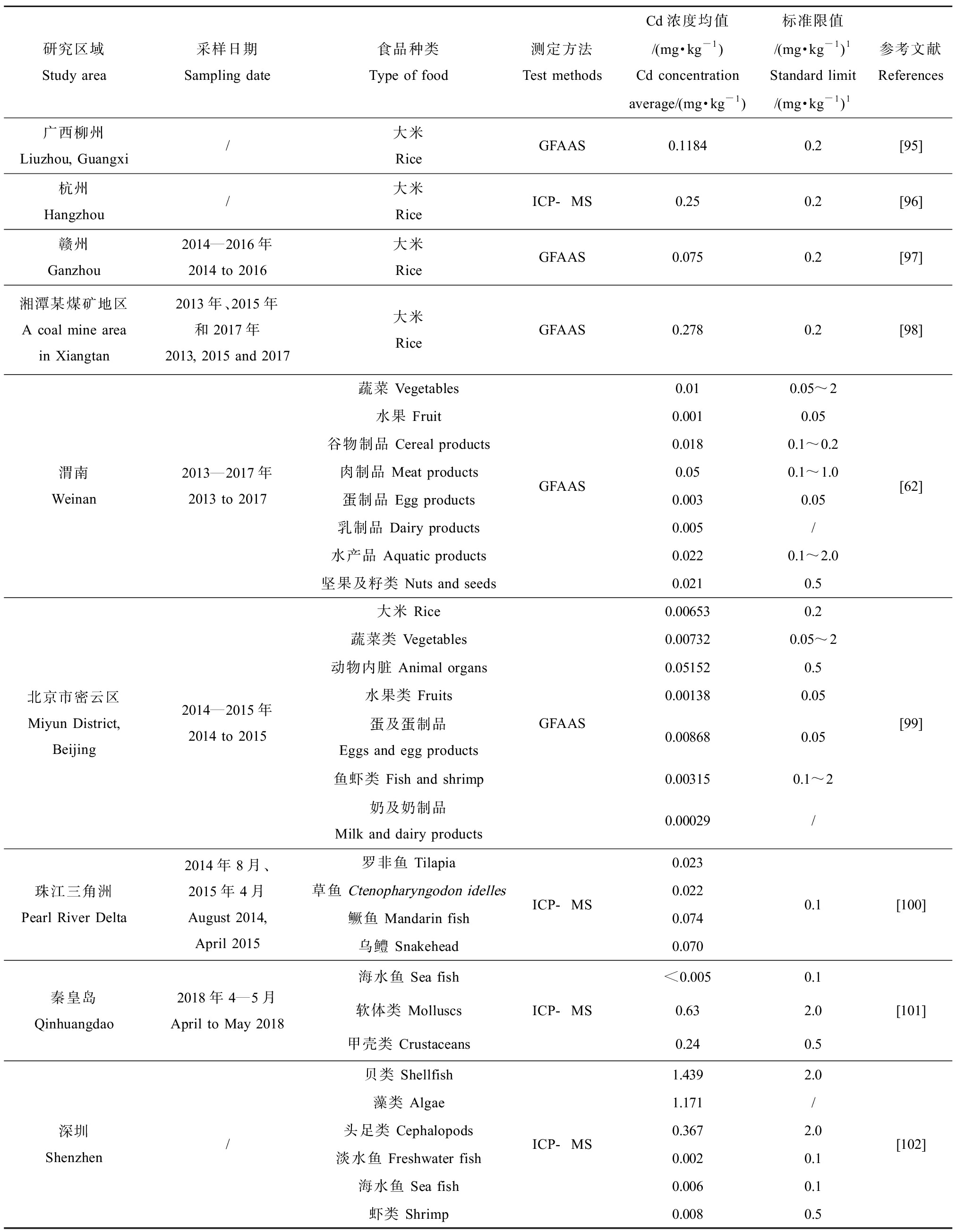
研究区域Study area采样日期Sampling date食品种类Type of food测定方法Test methodsCd浓度均值/(mg·kg-1)Cd concentration average/(mg·kg-1)标准限值/(mg·kg-1)1Standard limit/(mg·kg-1)1参考文献References广西柳州Liuzhou, Guangxi/大米RiceGFAAS0.11840.2[95]杭州Hangzhou/大米RiceICP-MS0.250.2[96]赣州Ganzhou2014—2016年2014 to 2016大米RiceGFAAS0.0750.2[97]湘潭某煤矿地区A coal mine area in Xiangtan2013年、2015年和2017年2013, 2015 and 2017大米RiceGFAAS0.2780.2[98]渭南Weinan2013—2017年2013 to 2017蔬菜 Vegetables水果 Fruit谷物制品 Cereal products肉制品 Meat products蛋制品 Egg products乳制品 Dairy products水产品 Aquatic products坚果及籽类 Nuts and seedsGFAAS0.010.05~20.0010.050.0180.1~0.20.050.1~1.00.0030.050.005/0.0220.1~2.00.0210.5[62]北京市密云区Miyun District, Beijing2014—2015年2014 to 2015大米 Rice蔬菜类 Vegetables动物内脏 Animal organs水果类 Fruits蛋及蛋制品Eggs and egg products鱼虾类 Fish and shrimp奶及奶制品Milk and dairy productsGFAAS0.006530.20.007320.05~20.051520.50.001380.050.008680.050.003150.1~20.00029/[99]珠江三角洲Pearl River Delta2014年8月、2015年4月August 2014, April 2015罗非鱼 Tilapia草鱼 Ctenopharyngodon idelles鳜鱼 Mandarin fish乌鳢 SnakeheadICP-MS0.0230.0220.0740.0700.1[100]秦皇岛Qinhuangdao2018年4—5月April to May 2018海水鱼 Sea fish软体类 Molluscs甲壳类 CrustaceansICP-MS<0.0050.10.632.00.240.5[101]深圳Shenzhen/贝类 Shellfish藻类 Algae头足类 Cephalopods淡水鱼 Freshwater fish海水鱼 Sea fish虾类 ShrimpICP-MS1.4392.01.171/0.3672.00.0020.10.0060.10.0080.5[102]
注:/表示该文章未注明;1《食品安全国家标准 食品中污染物限量》(GB 2762—2017)[103]。
Note: / means that the data is not noted in the article; 1 National Food Safety Standard Limits of Contaminants in Foods (GB 2762—2017) [103].
5 镉的暴露途径(Cadmium exposure route)
镉的暴露途径主要包括:呼吸吸入、食物及饮水摄入、经皮肤接触吸收[106]。
5.1 呼吸吸入
对于职业性暴露来说,呼吸吸入是镉暴露的一个重要途径。长期暴露于镉烟雾和粉尘场所中,通过呼吸系统吸收并沉积在肺部增加镉对人体的危害,甚至可能会导致肾小管功能障碍[107]。吸烟[108]也是镉暴露的一个重要途径,研究表明人体每天吸20支烟,约有1 μg镉吸入人体[109]。
5.2 食物及饮水摄入
食物摄入及饮水是非吸烟、非职业性暴露人群的主要接触途径[110]。食物中的镉从肠胃道吸收进入人体的量约为3%~5%,镉能蓄积在人体的肾脏以及肝脏中,半衰期长达10~30年[111]。
5.3 经皮肤接触吸收
经皮肤吸收进入人体的镉的量很少,仅有<1%。皮肤表皮有角质层,同时真皮是一种致密结缔组织,皮肤镉的渗透率低[112],长时间、高镉背景下、大面积体表镉暴露需引起重视。
6 镉的健康风险评价与防控措施(Health risk assessment and prevention and control measures of cadmium)
6.1 健康风险评价方法
当前,污染物暴露的健康风险评价主要基于美国科学院(NAS)的四步法:危害识别、剂量反应评估、暴露评估和风险表征[12,113]。
危害识别是通过收集、分析毒理学和流行病学资料,判断污染物对人体健康造成的损害,可分为致癌和非致癌。目前,可通过查询国际癌症研究中心和美国环境保护局综合风险信息系统(IRIS)等数据库,获得重金属元素的致癌分类[114-115]。
剂量-反应评估是通过建立污染物的暴露剂量与暴露人群之间产生不良反应发生率的关系,定量估计其对人体的健康风险[116]。剂量-反应关系的评估又分为阂限值和非阂限值评定,前者用于评估剂量-反应的非致癌效应终点,后者用于评估化学致癌效应的剂量-反应关系[117]。
暴露评估是通过测量或估计人群暴露于某种污染的暴露途径、暴露频率、暴露量以及暴露期而进行评价,是风险评价的定量依据[118]。
健康风险表征是基于危害识别、剂量-反应评估、暴露评估,估算重金属元素在不同暴露途径对人体健康产生的危害,主要分致癌风险与非致癌风险。
6.2 镉暴露的健康风险评价现状
国内外研究者,对镉暴露的健康风险进行了一定的研究。王永晓等[119]分析北京地区颗粒物中重金属的健康风险,结果表明,所研究的重金属元素的致癌和非致癌健康风险在安全范围内;李洋等[120]对滇东高镉背景区菜地土壤健康风险进行评价,结果表明,该地区蔬菜中的镉对儿童以及成人没有致癌风险,但镉对儿童的暴露风险高于成人;Agustina等[121]对垃圾填埋场地下水中镉的环境健康风险进行评价,结果表明,该研究区域地下水中镉暂无致癌风险,但该研究只单一研究饮水摄入风险不能很好诠释该地区镉暴露的健康风险;Chen等[122]综述了华南地区镉的健康风险评价研究成果,结果表明0~5岁儿童总镉暴露量最高,华南地区不同人群(0~5岁、6~17岁和成人)多途径Cd暴露后处于不可接受的危险水平;Du等[123]对某铅锌矿和铜冶炼厂附近人群镉暴露进行健康风险评价,结果显示,儿童潜在的非致癌风险是成人的1.2倍。
综上,当前镉暴露的健康风险评价趋于多途径暴露风险评价。多途径暴露评价,可以更好地评估人体镉的暴露风险,同时对于不同人群镉暴露的健康风险评价及其影响因素有系统深入研究的必要。
6.3 镉的联合防控
镉对健康和环境产生伤害和危害,且难去除,需多方面联合防控:(1)在污染源头严格防控,控制工业含镉“三废”及含镉生活垃圾的排放[124];(2)对镉污染的土壤采取改良措施及时修复,防止镉迁移,在土壤中施用含硅肥料,减少农作物对土壤镉的吸收;在土壤中施加生石灰,提高土壤pH值,降低土壤中有效镉含量[125-126];(3)对镉污染的水体及时净化,采用吸附、化学沉淀等方法净化处理水体中的镉[127];(4)避免或减少镉暴露,加强含镉食物检测,减少高镉含量产品的食用;提醒烟民减少吸烟频率,公共场合禁烟,防止非烟民摄入二手含镉烟雾。
7 研究展望(Research outlook)
镉对人体的健康影响受到重视,镉的检测和镉暴露与健康风险评价已取得一定的研究成果,但仍有不足:(1)不同介质中镉的形态存在较大差异,检测技术尚存不足,致使镉的生物有效性评价具有不确定性;(2)目前镉检测技术前处理过程繁琐、成本较高,镉的快速检测尚未实现;(3)不同区域、多途径、不同人群的镉暴露风险评价关注度不够。
研究展望如下:(1)针对不同介质开展镉不同形态的检测,为镉的生物有效性性评估和镉暴露的健康风险评价提供准确的基础数据;(2)不同介质中镉形态提取和检测方法的改进与创新,争取实现快速检测;(3)关注不同区域、不同人群、多途径镉暴露评价,科学、准确地评估不同人群的健康风险,为建立不同来源镉暴露的健康风险评价以及分类管控方法奠定相应的理论基础。
[1] Ahn S C, Chang J Y, Lee J S, et al. Exposure factors of cadmium for residents in an abandoned metal mine area in Korea [J]. Environmental Geochemistry and Health, 2017, 39(5): 1059-1070
[2] Fatoba P, Ogunkunle C, Salihu B. Toxic effects of cadmium (Cd) and lead (Pb) on growth and productivity of Arachis hypogaea and Glycine max [J]. Asian Journal of Scientific Research, 2012, 2(5): 254-259
[3] Joseph P. Mechanisms of cadmium carcinogenesis [J]. Toxicology and Applied Pharmacology, 2009, 238(3): 272-279
[4] 丁鸿, 杨杏芬. 环境镉危害早期健康效应风险评估的研究进展[J]. 国外医学(卫生学分册), 2007(5): 279-282
[5] 刘莉莉, 林岚, 殷霄, 等. 镉毒性研究进展[J]. 中国职业医学, 2012, 39(5): 445-447
Liu L L, Lin L, Yin X, et al. Research progress on cadmium toxicity [J]. China Occupational Medicine, 2012, 39(5): 445-447 (in Chinese)
[6] Qing Y, Yang J Q, Zhu Y S, et al. Cancer risk and disease burden of dietary cadmium exposure changes in Shanghai residents from 1988 to 2018 [J]. The Science of the Total Environment, 2020, 734: 139411
[7] 戴洪文, 宋秀贤, 辛俊亮, 等. 中国大米重金属健康风险评估研究进展[J]. 安徽农业科学, 2016, 44(29): 60-62, 77
Dai H W, Song X X, Xin J L, et al. Research progress on health risk assessment of heavy metals via consumption of rice in China [J]. Journal of Anhui Agricultural Sciences, 2016, 44(29): 60-62, 77 (in Chinese)
[8] 吴婧, 董欣敏, 郑燕芳, 等. 镉致癌的分子机制研究进展[J]. 生态毒理学报, 2015, 10(6): 54-61
Wu J, Dong X M, Zheng Y F, et al. Recent research progress in molecular mechanisms of cadmium induced carcinogenesis [J]. Asian Journal of Ecotoxicology, 2015, 10(6): 54-61 (in Chinese)
[9] Mezynska M, Brzóska M M. Environmental exposure to cadmium—A risk for health of the general population in industrialized countries and preventive strategies [J]. Environmental Science and Pollution Research, 2018, 25(4): 3211-3232
[10] Sarma S N, Saleem A, Lee J Y, et al. Effects of long-term cadmium exposure on urinary metabolite profiles in mice [J]. The Journal of Toxicological Sciences, 2018, 43(2): 89-100
[11] 朱华龙, 熊永伟, 王华. 镉对胚胎/胎儿发育的损害作用及其机制[J]. 环境与职业医学, 2019, 36(2): 151-156
Zhu H L, Xiong Y W, Wang H. Adverse effects of cadmium on embryonic and fetal development and its mechanism [J]. Journal of Environmental and Occupational Medicine, 2019, 36(2): 151-156 (in Chinese)
[12] 杨彦, 陆晓松, 李定龙. 我国环境健康风险评价研究进展[J]. 环境与健康杂志, 2014, 31(4): 357-363
Yang Y, Lu X S, Li D L. Research progress of environmental health risk assessment in China [J]. Journal of Environment and Health, 2014, 31(4): 357-363 (in Chinese)
[13] Ma Y K, Egodawatta P, McGree J, et al. Human health risk assessment of heavy metals in urban stormwater [J]. The Science of the Total Environment, 2016, 557-558: 764-772
[14] Coc r
r ă D M, Neam
ă D M, Neam u S, Deac A M R. Carcinogenic risk evaluation for human health risk assessment from soils contaminated with heavy metals [J]. International Journal of Environmental Science and Technology, 2016, 13(8): 2025-2036
u S, Deac A M R. Carcinogenic risk evaluation for human health risk assessment from soils contaminated with heavy metals [J]. International Journal of Environmental Science and Technology, 2016, 13(8): 2025-2036
[15] He B, Yun Z J, Shi J B, et al. Research progress of heavy metal pollution in China: Sources, analytical methods, status, and toxicity [J]. Chinese Science Bulletin, 2013, 58(2): 134-140
[16] 杜丽娜, 余若祯, 王海燕, 等. 重金属镉污染及其毒性研究进展[J]. 环境与健康杂志, 2013, 30(2): 167-174
Du L N, Yu R Z, Wang H Y, et al. Pollution and toxicity of cadmium: A review of recent studies [J]. Journal of Environment and Health, 2013, 30(2): 167-174 (in Chinese)
[17] 赵静, 孙海娟, 冯叙桥. 食品中重金属镉污染状况及其检测技术研究进展[J]. 食品工业科技, 2014, 35(16): 371-376
Zhao J, Sun H J, Feng X Q. Research progress in pollution of heavy metals cadmium and its detection technology in food [J]. Science and Technology of Food Industry, 2014, 35(16): 371-376 (in Chinese)
[18] 卢春, 黄磊, 易文涛, 等. 城市大气颗粒物中重金属形态及分布特征研究综述[J]. 山东化工, 2015, 44(18): 150-154
Lu C, Huang L, Yi W T, et al. Research summary on the morphology and distribution characteristics of heavy metals of urban air particulate matters [J]. Shandong Chemical Industry, 2015, 44(18): 150-154 (in Chinese)
[19] 顾佳丽, 刘璐, 刘畅, 等. 锦州市大气颗粒物中重金属形态分析及生物有效性评价[J]. 化学研究与应用, 2016, 28(8): 1136-1140
Gu J L, Liu L, Liu C, et al. Speciation analysis and bioaccessibility of heavy metal in atmospheric particulate matters from Jinzhou [J]. Chemical Research and Application, 2016, 28(8): 1136-1140 (in Chinese)
[20] 陆喜红, 任兰, 吴丽娟. 南京市大气PM2.5中重金属分布特征及化学形态分析[J]. 环境监控与预警, 2019, 11(1): 40-44
Lu X H, Ren L, Wu L J. Research on the distribution characteristics and chemical speciation of heavy metals in PM2.5 in Nanjing [J]. Environmental Monitoring and Forewarning, 2019, 11(1): 40-44 (in Chinese)
[21] 张宝军, 朱蒙曼, 王鹏, 等. 赣江流域水体中可溶态镉的时空分布特征及水质评价[J]. 生态与农村环境学报, 2014, 30(4): 495-499
Zhang B J, Zhu M M, Wang P, et al. Spatial and temporal distribution of dissolved cadmium in and water quality assessment of the water body of the Ganjiang River Catchment [J]. Journal of Ecology and Rural Environment, 2014, 30(4): 495-499 (in Chinese)
[22] 韩瑾, 李星, 杨艳玲, 等. 饮用水源突发镉污染的应急处理技术研究[J]. 中国给水排水, 2012, 28(21): 1-4
Han J, Li X, Yang Y L, et al. Emergency treatment of source water after cadmium pollution accident [J]. China Water & Wastewater, 2012, 28(21): 1-4 (in Chinese)
[23] 陈媛. 土壤中镉及镉的赋存形态研究进展[J]. 广东微量元素科学, 2007, 14(7): 7-13
Chen Y. Development of study on cadmium and its chemical speciation in soil [J]. Guangdong Trace Elements Science, 2007, 14(7): 7-13 (in Chinese)
[24] 张鑫, 周涛发, 袁峰, 等. 铜陵矿区土壤中镉存在形态及生物有效性[J]. 生态环境, 2004, 13(4): 572-574
Zhang X, Zhou T F, Yuan F, et al. Speciation and bioavailability of cadmium in Tongling mining soils [J]. Ecology and Environmental Sciences, 2004, 13(4): 572-574 (in Chinese)
[25] 龚媛媛, 雷家立, 张茂忠, 等. 巫山建坪燃煤型氟中毒地区土壤高镉的来源及赋存状态研究[J]. 地球与环境, 2009, 37(1): 37-41
Gong Y Y, Lei J L, Zhang M Z, et al. The source and geochemical speciation of high cadmium in soil in the Jianping area, Wushan, Chongqing, with endemic fluorosis related to coal combustion [J]. Earth and Environment, 2009, 37(1): 37-41 (in Chinese)
[26] 钟志淋, 邴海健, 吴艳宏, 等. 三峡库区丰都-忠县段消落带不同高程土壤镉及其形态的分布特征[J]. 湖泊科学, 2019, 31(6): 1601-1611
Zhong Z L, Bing H J, Wu Y H, et al. Distribution of cadmium in soils along the altitude of riparian zone (Fengdu-Zhongxian section) in the Three Gorges Reservoir region [J]. Journal of Lake Sciences, 2019, 31(6): 1601-1611 (in Chinese)
[27] Sandroni V, Smith C M, Donovan A. Microwave digestion of sediment, soils and urban particulate matter for trace metal analysis [J]. Talanta, 2003, 60(4): 715-723
[28] 弓晓峰, 陈春丽, Barbara Zimmermann, 等. ICP-AES测定湖泊沉积物中微量元素的样品微波消解研究[J]. 光谱学与光谱分析, 2007, 27(1): 155-159
Gong X F, Chen C L, Zimmermann B, et al. Study on microwave digestion of sediment of Poyang Lake determined by ICP-AES [J]. Spectroscopy and Spectral Analysis, 2007, 27(1): 155-159 (in Chinese)
[29] 郑红艳, 郭雪勤, 朱志勋, 等. 全自动石墨消解-电感耦合等离子体质谱测定鱼、虾等生物样品中铜、镉、锌、铬4种重金属元素[J]. 食品安全质量检测学报, 2017, 8(1): 270-274
Zheng H Y, Guo X Q, Zhu Z X, et al. Determination of Cu, Cd, Cr and Zn in fish and shrimp by automated graphite digestion combined with inductively coupled plasma mass spectrometry [J]. Journal of Food Safety & Quality, 2017, 8(1): 270-274 (in Chinese)
[30] 李承. 全自动石墨消解-ICP-MS法测定土壤中的重金属含量[J]. 广东化工, 2016, 43(21): 162-163
Li C. Determination of six kinds of heavy metal in soil by automatic graphite digestion-ICP-MS [J]. Guangdong Chemical Industry, 2016, 43(21): 162-163 (in Chinese)
[31] Gao J J, Liu J H, Li X G, et al. The determination of 52 elements in marine geological samples by an inductively coupled plasma optical emission spectrometry and an inductively coupled plasma mass spectrometry with a high-pressure closed digestion method [J]. Acta Oceanologica Sinica, 2017, 36(1): 109-117
[32] 胡林凯, 于云江, 孙朋, 等. 高压密封罐消解ICP-MS法测定底泥中重金属元素[J]. 安徽农业科学, 2010, 38(11): 5805-5806, 5901
Hu L K, Yu Y J, Sun P, et al. Determination of heavy metals in sediment by high pressure sealed vessels assisted digestion-inductively coupled plasma mass spectrometry [J]. Journal of Anhui Agricultural Sciences, 2010, 38(11): 5805-5806, 5901 (in Chinese)
[33] 李欣, 吴跃, 周文化, 等. 湿法消解条件对大米中镉定量检测的影响[J]. 粮食与油脂, 2016, 29(6): 82-84
Li X, Wu Y, Zhou W H, et al. Effect of wet digestion conditions on the quantitative detection of cadmium in rice [J]. Cereals & Oils, 2016, 29(6): 82-84 (in Chinese)
[34] Feng H T. Wet digestion techniques for determination of chromium in food sample by differential pulse stripping voltammetry [J]. International Journal of Electrochemical Science, 2020, 15: 12192-12202
[35] Lv W X, Yin H M, Liu M S, et al. Effect of the dry-ashing method on cadmium isotope measurements in soil and plant samples [J]. Geostandards and Geoanalytical Research, 2020, 45(1): 245-256
[36] Adeloju S B, Bond A M, Noble M L. Evaluation of some dry ashing methods for anodic stripping voltammetric determination of cadmium and lead in biological materials [J]. Analytica Chimica Acta, 1984, 161: 303-314
[37] Tessier A, Campbell P G C, Bisson M. Sequential extraction procedure for the speciation of particulate trace metals [J]. Analytical Chemistry, 1979, 51(7): 844-851
[38] Ure A M, Quevauviller P, Muntau H, et al. Speciation of heavy metals in soils and sediments. An account of the improvement and harmonization of extraction techniques undertaken under the auspices of the BCR of the commission of the European communities [J]. International Journal of Environmental Analytical Chemistry, 1993, 51(1-4): 135-151
[39] Rauret G, López-Sánchez J F, Sahuquillo A, et al. Improvement of the BCR three step sequential extraction procedure prior to the certification of new sediment and soil reference materials [J]. Journal of Environmental Monitoring, 1999, 1(1): 57-61
[40] Sagagi B S, Imam T S. Fractionation of potentially toxic elements (PTE) in soils irrigated with wastewater using modified BCR sequential extraction procedure [J]. Bayero Journal of Pure and Applied Sciences, 2017, 10(1): 300
[41] 王国莉, 陈孟君, 范红英, 等. 四种土壤重金属形态分析方法的对比研究[J]. 浙江农业学报, 2015, 27(11): 1977-1983
Wang G L, Chen M J, Fan H Y, et al. Comparison of four speciation analytical methods for soil heavy metals [J]. Acta Agriculturae Zhejiangensis, 2015, 27(11): 1977-1983 (in Chinese)
[42] Bustos A R M. The role of ICP-MS in separation science [J]. Chromatographia, 2019, 83(2): 145-147
[43] 王伟, 孔少飞, 刘海彪, 等. 南京市春节前后大气PM2.5中重金属来源及健康风险评价[J]. 中国环境科学, 2016, 36(7): 2186-2195
Wang W, Kong S F, Liu H B, et al. Sources and risk assessment of heavy metals in PM2.5 around 2014 Spring Festival in Nanjing [J]. China Environmental Science, 2016, 36(7): 2186-2195 (in Chinese)
[44] 朱美霖, 杨晓莉, 赵建明, 等. 宁夏村镇饮用水中重金属暴露健康风险评估及不确定性分析[J]. 生态毒理学报, 2020, 15(5): 372-378
Zhu M L, Yang X L, Zhao J M, et al. Health risk assessment and uncertainty analysis based on heavy metals exposure by drinking water in Ningxia rural areas [J]. Asian Journal of Ecotoxicology, 2020, 15(5): 372-378 (in Chinese)
[45] 刘春林, 张建, 彭益书, 等. 贵州雷山茶区土壤-茶叶重金属含量特征及饮茶风险评价[J]. 浙江农业学报, 2020, 32(6): 1049-1059
Liu C L, Zhang J, Peng Y S, et al. Contents and health risks assessment of heavy metals in soil and tea in Leishan, Guizhou Province [J]. Acta Agriculturae Zhejiangensis, 2020, 32(6): 1049-1059 (in Chinese)
[46] Rodríguez J A, Nanos N, Grau J M, et al. Multiscale analysis of heavy metal contents in Spanish agricultural topsoils [J]. Chemosphere, 2008, 70(6): 1085-1096
[47] Amjadian K, Sacchi E, Mehr M R. Heavy metals (HMs) and polycyclic aromatic hydrocarbons (PAHs) in soils of different land uses in Erbil metropolis, Kurdistan Region, Iraq [J]. Environmental Monitoring and Assessment, 2016, 188(11): 605
[48] Butcher D J. Atomic fluorescence spectrometry: A review of advances in instrumentation and novel applications [J]. Applied Spectroscopy Reviews, 2016, 51(5): 397-416
[49] Towett E K, Shepherd K D, Cadisch G. Quantification of total element concentrations in soils using total X-ray fluorescence spectroscopy (TXRF) [J]. Science of the Total Environment, 2013, 463-464: 374-388
[50] Adimalla N. Heavy metals contamination in urban surface soils of Medak Province, India, and its risk assessment and spatial distribution [J]. Environmental Geochemistry and Health, 2020, 42(1): 59-75
[51] F rat M, Bodur S, T
rat M, Bodur S, T
 l
l B, et al. Vortex-assisted switchable liquid-liquid microextraction for the preconcentration of cadmium in environmental samples prior to its determination with flame atomic absorption spectrometry [J]. Environmental Monitoring and Assessment, 2018, 190(7): 393
B, et al. Vortex-assisted switchable liquid-liquid microextraction for the preconcentration of cadmium in environmental samples prior to its determination with flame atomic absorption spectrometry [J]. Environmental Monitoring and Assessment, 2018, 190(7): 393
[52] Islam A R M T, Kabir M M, Faruk S, et al. Sustainable groundwater quality in southeast coastal Bangladesh: Co-dispersions, sources, and probabilistic health risk assessment [J]. Environment, Development and Sustainability, 2021, 23(12): 18394-18423
[53] Romic M, Romic D. Heavy metals distribution in agricultural topsoils in urban area [J]. Environmental Geology, 2003, 43(7): 795-805
[54] 周国宏, 彭朝琼, 余淑苑, 等. 深圳市饮用水源水中重金属污染物健康风险评价[J]. 环境与健康杂志, 2011, 28(1): 50-52
Zhou G H, Peng Z Q, Yu S Y, et al. Health risk assessment of heavy metals in drinking water sources in Shenzhen, Guangdong [J]. Journal of Environment and Health, 2011, 28(1): 50-52 (in Chinese)
[55] 刘艳, 方鑫, 徐肖倩, 等. 2018年呼和浩特市饮用水中重金属污染物的健康风险评价[J]. 现代预防医学, 2020, 47(11): 2065-2069
Liu Y, Fang X, Xu X Q, et al. Health risk assessment of heavy metal pollutants in drinking water in Hohhot, 2018 [J]. Modern Preventive Medicine, 2020, 47(11): 2065-2069 (in Chinese)
[56] Rogula-Koz owska W, Klejnowski K, Rogula-Kopiec P, et al. Spatial and seasonal variability of the mass concentration and chemical composition of PM2.5 in Poland [J]. Air Quality, Atmosphere, & Health, 2014, 7(1): 41-58
owska W, Klejnowski K, Rogula-Kopiec P, et al. Spatial and seasonal variability of the mass concentration and chemical composition of PM2.5 in Poland [J]. Air Quality, Atmosphere, & Health, 2014, 7(1): 41-58
[57] 胡子梅, 王军, 陶征楷, 等. 上海市PM2.5重金属污染水平与健康风险评价[J]. 环境科学学报, 2013, 33(12): 3399-3406
Hu Z M, Wang J, Tao Z K, et al. Pollution level and health risk assessment of heavy metals in PM2.5, Shanghai [J]. Acta Scientiae Circumstantiae, 2013, 33(12): 3399-3406 (in Chinese)
[58] Muhammad S, Shah M T, Khan S. Health risk assessment of heavy metals and their source apportionment in drinking water of Kohistan region, northern Pakistan [J]. Microchemical Journal, 2011, 98(2): 334-343
[59] Seleem E M, Mostafa A, Mokhtar M, et al. Risk assessment of heavy metals in drinking water on the human health, Assiut City, and its environs, Egypt [J]. Arabian Journal of Geosciences, 2021, 14(6): 427
[60] 张俊丽, 雷建新, 赵晓进, 等. 陕西省潼关县农田重金属污染分析与评价[J]. 西北农业学报, 2019, 28(2): 247-252
Zhang J L, Lei J X, Zhao X J, et al. Analysis of heavy metal contamination in farmland soil of Tongguan County, Shaanxi Province [J]. Acta Agriculturae Boreali-Occidentalis Sinica, 2019, 28(2): 247-252 (in Chinese)
[61] 崔邢涛, 栾文楼, 宋泽峰, 等. 石家庄城市土壤重金属空间分布特征及源解析[J]. 中国地质, 2016, 43(2): 683-690
Cui X T, Luan W L, Song Z F, et al. A study of the spatial distribution and source of heavy metals in urban soil in Shijiazhuang City [J]. Geology in China, 2016, 43(2): 683-690 (in Chinese)
[62] 刘孟文, 杨欢欢, 赵一鹏, 等. 2013—2017年渭南市市售8类食品中重金属污染状况[J]. 卫生研究, 2019, 48(1): 136-139
[63] 李友平, 刘慧芳, 周洪, 等. 成都市PM2.5中有毒重金属污染特征及健康风险评价[J]. 中国环境科学, 2015, 35(7): 2225-2232
Li Y P, Liu H F, Zhou H, et al. Contamination characteristics and health risk assessment of toxic heavy metals in PM2.5 in Chengdu [J]. China Environmental Science, 2015, 35(7): 2225-2232 (in Chinese)
[64] 何瑞东, 张轶舜, 陈永阳, 等. 郑州市某生活区大气PM2.5中重金属污染特征及生态、健康风险评估[J]. 环境科学, 2019, 40(11): 4774-4782
He R D, Zhang Y S, Chen Y Y, et al. Heavy metal pollution characteristics and ecological and health risk assessment of atmospheric PM2.5 in a living area of Zhengzhou City [J]. Environmental Science, 2019, 40(11): 4774-4782 (in Chinese)
[65] 聂莉, 李延升, 华正罡, 等. 辽宁沈阳地区大气PM2.5中重金属污染特征及健康风险评价[J]. 中国公共卫生, 2018, 34(4): 574-576
Nie L, Li Y S, Hua Z G, et al. Pollution characteristics and related health risk of heavy metals in PM2.5 in Shenyang City of Liaoning Province [J]. Chinese Journal of Public Health, 2018, 34(4): 574-576 (in Chinese)
[66] 赵岩, 冯利红, 刘洪亮, 等. 天津市冬季大气PM2.5中金属元素污染特征及健康风险评价[J]. 中华疾病控制杂志, 2016, 20(3): 294-298
Zhao Y, Feng L H, Liu H L, et al. Pollution characteristics analysis and health risk assessment of metals in PM2.5 in winter of Tianjin [J]. Chinese Journal of Disease Control & Prevention, 2016, 20(3): 294-298 (in Chinese)
[67] 吴宪初, 陈彬, 温天雪, 等. 北京和伊斯兰堡冬季PM10中物质浓度和化学组分的对比[J]. 山东大学学报(理学版), 2019, 54(7): 42-49, 56
Wu X C, Chen B, Wen T X, et al. Comparison of concentrations and chemical compositions of PM10 during hazy and non-hazy days in Beijing and Islamabad [J]. Journal of Shandong University (Natural Science), 2019, 54(7): 42-49, 56 (in Chinese)
[68] 谭吉华, 段菁春. 中国大气颗粒物重金属污染、来源及控制建议[J]. 中国科学院研究生院学报, 2013, 30(2): 145-155
Tan J H, Duan J C. Heavy metals in aerosol in China: Pollution, sources, and control strategies [J]. Journal of Graduate University of Chinese Academy of Sciences, 2013, 30(2): 145-155 (in Chinese)
[69] von Schneidemesser E, Stone E A, Quraishi T A, et al. Toxic metals in the atmosphere in Lahore, Pakistan [J]. The Science of the Total Environment, 2010, 408(7): 1640-1648
[70] Park K, Dam H D. Characterization of metal aerosols in PM10 from urban, industrial, and Asian Dust sources [J]. Environmental Monitoring and Assessment, 2010, 160(1): 289
[71] Gao Y. Characterization of atmospheric trace elements on PM2.5 particulate matter over the New York-New Jersey Harbor Estuary [J]. Atmospheric Environment, 2002, 36(6): 1077-1086
[72] 中国国家质量监督检验检疫总局, 中国国家标准化管理委员会. 环境空气质量标准: GB 3095—2012[S]. 北京: 中国环境科学出版社, 2016
[73] World Health Organization (WHO). Air quality guidelines-global update 2005[R]. Bonn: WHO Regional Office for Europe, 2005
[74] 高继军, 张力平, 黄圣彪, 等. 北京市饮用水源水重金属污染物健康风险的初步评价[J]. 环境科学, 2004, 25(2): 47-50
Gao J J, Zhang L P, Huang S B, et al. Preliminary health risk assessment of heavy metals in drinking waters in Beijing [J]. Environmental Science, 2004, 25(2): 47-50 (in Chinese)
[75] 陈春静, 张景山, 李峻, 等. 2019年南京市饮用水重金属健康风险评估[J]. 现代预防医学, 2020, 47(5): 813-816
Chen C J, Zhang J S, Li J, et al. Health risk assessment of heavy metals in drinking water, Nanjing, 2019 [J]. Modern Preventive Medicine, 2020, 47(5): 813-816 (in Chinese)
[76] 彭小玉, 周理程, 潘海婷, 等. 长沙城区主要饮用水源重金属健康风险的初步评价[J]. 环境与健康杂志, 2019, 36(10): 933-936
[77] Wongsasuluk P, Chotpantarat S, Siriwong W, et al. Heavy metal contamination and human health risk assessment in drinking water from shallow groundwater wells in an agricultural area in Ubon Ratchathani Province, Thailand [J]. Environmental Geochemistry and Health, 2014, 36(1): 169-182
[78] 中华人民共和国卫生部, 中国国家标准化管理委员会. 生活饮用水卫生标准: GB 5749—2006[S]. 北京: 中国标准出版社, 2007
[79] United States Environmental Protection Agency (US EPA). The Drinking Water Standards and Health Advisories[S]. Washington DC: US EPA, 2018
[80] World Health Organization (WHO). Guidelines for Drinking-water Quality[S]. 4th Ed. Geneva: WHO, 2011
[81] Yuan X H, Xue N D, Han Z G. A meta-analysis of heavy metals pollution in farmland and urban soils in China over the past 20 years [J]. Journal of Environmental Sciences (China), 2021, 101: 217-226
[82] 彭丽梅, 赵理, 周悟, 等. 广州市从化区耕地土壤重金属风险评价[J]. 广西师范大学学报(自然科学版), 2020, 38(5): 118-129
Peng L M, Zhao L, Zhou W, et al. Risk assessment of heavy metals in cultivated land in Conghua District of Guangzhou City, China [J]. Journal of Guangxi Normal University (Natural Science Edition), 2020, 38(5): 118-129 (in Chinese)
[83] 邵金秋, 刘楚琛, 阎秀兰, 等. 河北省典型污灌区农田镉污染特征及环境风险评价[J]. 环境科学学报, 2019, 39(3): 917-927
Shao J Q, Liu C C, Yan X L, et al. Cadmium distribution characteristics and environmental risk assessment in typical sewage irrigation area of Hebei Province [J]. Acta Scientiae Circumstantiae, 2019, 39(3): 917-927 (in Chinese)
[84] 许萌萌, 刘爱风, 师荣光, 等. 天津农田重金属污染特征分析及降雨沥浸影响[J]. 环境科学, 2018, 39(3): 1095-1101
Xu M M, Liu A F, Shi R G, et al. Characteristics of heavy metals pollution of farmland and the leaching effect of rainfall in Tianjin [J]. Environmental Science, 2018, 39(3): 1095-1101 (in Chinese)
[85] Esmaeili A. A geochemical survey of heavy metals in agricultural and background soils of the Isfahan industrial zone, Iran [J]. Catena, 2014, 121: 88-98
[86] Kelepertzis E. Accumulation of heavy metals in agricultural soils of Mediterranean: Insights from Argolida Basin, Peloponnese, Greece [J]. Geoderma, 2014, 221-222(27): 82-90
[87] 中华人民共和国生态环境部, 中国国家市场监督管理总局. 土壤环境质量 农用地土壤污染风险管控标准: GB 15618—2018[S]. 北京: 中国标准出版社, 2018
[88] 张妍, 李玉嵩, 谷志云, 等. 商丘城市土壤重金属污染及潜在生态风险评价研究[J]. 环境科学与管理, 2019, 44(7): 186-190
Zhang Y, Li Y S, Gu Z Y, et al. Heavy metal pollution and potential ecological risk assessment in urban soils of Shangqiu City [J]. Environmental Science and Management, 2019, 44(7): 186-190 (in Chinese)
[89] 刘勇, 岳玲玲, 李晋昌. 太原市土壤重金属污染及其潜在生态风险评价[J]. 环境科学学报, 2011, 31(6): 1285-1293
Liu Y, Yue L L, Li J C. Evaluation of heavy metal contamination and its potential ecological risk to the soil in Taiyuan, China [J]. Acta Scientiae Circumstantiae, 2011, 31(6): 1285-1293 (in Chinese)
[90] 姚文文, 陈文德, 黄钟宣, 等. 重庆市主城区土壤重金属形态特征及风险评价[J]. 西南农业学报, 2021, 34(1): 159-164
Yao W W, Chen W D, Huang Z X, et al. Speciation characteristics and risk assessment of heavy metals in soil in core zone of Chongqing [J]. Southwest China Journal of Agricultural Sciences, 2021, 34(1): 159-164 (in Chinese)
[91] 张久明, 迟凤琴, 宿庆瑞, 等. 哈尔滨市城市土壤重金属空间分布特征及相关分析[J]. 东北农业大学学报, 2010, 41(7): 56-61
Zhang J M, Chi F Q, Su Q R, et al. Study on spatial variability of soil heavy metal in Harbin building area [J]. Journal of Northeast Agricultural University, 2010, 41(7): 56-61 (in Chinese)
[92] 王凯, 凌其聪. 武汉市城市土壤重金属粒径分布特征[J]. 环境化学, 2013, 32(12): 2329-2335
Wang K, Ling Q C. Particla-siz distribution of heavy metals in urban soil of Wuhan, China [J]. Environmental Chemistry, 2013, 32(12): 2329-2335 (in Chinese)
[93] Mehr M R, Keshavarzi B, Moore F, et al. Distribution, source identification and health risk assessment of soil heavy metals in urban areas of Isfahan Province, Iran [J]. Journal of African Earth Sciences, 2017, 132: 16-26
[94] Guagliardi I, Cicchella D, De Rosa R. A geostatistical approach to assess concentration and spatial distribution of heavy metals in urban soils [J]. Water, Air, & Soil Pollution, 2012, 223(9): 5983-5998
[95] 李艳飞, 谢昌平, 李德洁, 等. 柳州地区自产大米中镉、铅和砷污染状况及其健康风险评价[J]. 中国卫生检验杂志, 2020, 30(24): 3026-3029
Li Y F, Xie C P, Li D J, et al. Cadmium, lead and arsenic pollution and health risk assessment of rice produced in Liuzhou area [J]. Chinese Journal of Health Laboratory Technology, 2020, 30(24): 3026-3029 (in Chinese)
[96] 任韧, 龚立科, 王姝婷, 等. 杭州产大米中重金属污染状况调查及暴露风险评估[J]. 中国卫生检验杂志, 2020, 30(12): 1516-1519, 1528
Ren R, Gong L K, Wang S T, et al. Survey of heavy metal contamination and risk assessment of exposure in Hangzhou indigenous rice [J]. Chinese Journal of Health Laboratory Technology, 2020, 30(12): 1516-1519, 1528 (in Chinese)
[97] 刘贤标, 李枝明, 黄赤忠, 等. 2014—2016年赣南地区大米中铅、镉的污染状况调查[J]. 食品安全导刊, 2017(24): 106-108
[98] 孙唤, 冯曦, 雷义华, 等. 湘潭某煤矿地区大米中镉污染调查及影响因素分析[J]. 中国卫生检验杂志, 2019, 29(3): 372-373, 384
Sun H, Feng X, Lei Y H, et al. Investigation of cadmium pollution in rice and its influencing factors in a coal mine area of Xiangtan [J]. Chinese Journal of Health Laboratory Technology, 2019, 29(3): 372-373, 384 (in Chinese)
[99] 冯月明, 郑德生, 李建超, 等. 北京市密云区居民膳食镉暴露风险评估[J]. 食品安全质量检测学报, 2017, 8(1): 355-359
Feng Y M, Zheng D S, Li J C, et al. Risk assessment of residents’ dietary exposure of cadmium in Miyun District of Beijing [J]. Journal of Food Safety & Quality, 2017, 8(1): 355-359 (in Chinese)
[100] 谢文平, 朱新平, 马丽莎, 等. 珠江三角洲4种淡水养殖鱼类重金属的残留及食用风险评价[J]. 生态毒理学报, 2017, 12(5): 294-303
Xie W P, Zhu X P, Ma L S, et al. Residues and safety evaluation of heavy metals in four species of freshwater fish from fish pond of Pearl River Delta [J]. Asian Journal of Ecotoxicology, 2017, 12(5): 294-303 (in Chinese)
[101] 王浩然, 伊丽丽, 王红卫, 等. 秦皇岛近海域海产品中铅、镉、汞和无机砷污染状况及食用风险评价[J]. 现代预防医学, 2018, 45(24): 4443-4446
Wang H R, Yi L L, Wang H W, et al. Safety evaluation of lead, cadmium, mercury and inorganic arsenic pollution in seafood in the offshore area of Qinhuangdao [J]. Modern Preventive Medicine, 2018, 45(24): 4443-4446 (in Chinese)
[102] 罗贤如, 张锦周, 王舟, 等. 深圳市市售水产品中的镉膳食暴露风险评估[J]. 现代预防医学, 2019, 46(2): 238-241
Luo X R, Zhang J Z, Wang Z, et al. Risk assessment of dietary exposure to cadmium from edible aquatic products sold in Shenzhen City [J]. Modern Preventive Medicine, 2019, 46(2): 238-241 (in Chinese)
[103] 中国国家卫生和计划生育委员会, 中国国家食品药品监督管理总局. 食品安全国家标准 食品中污染物限量: GB 2762—2017[S]. 北京: 中国标准出版社, 2017
[104] 黄芸, 袁洪, 黄志军, 等. 环境重金属暴露对人群健康危害研究进展[J]. 中国公共卫生, 2016, 32(8): 1113-1116
Huang Y, Yuan H, Huang Z J, et al. Progress in research on environmental exposure and health hazards of heavy metals in China [J]. Chinese Journal of Public Health, 2016, 32(8): 1113-1116 (in Chinese)
[105] Järup L, Akesson A. Current status of cadmium as an environmental health problem [J]. Toxicology and Applied Pharmacology, 2009, 238(3): 201-208
[106] Jirtle R L, Skinner M K. Environmental epigenomics and disease susceptibility [J]. Nature Reviews Genetics, 2007, 8(4): 253-262
[107] T Townsend A, A Miller K, McLean S, et al. The determination of copper, zinc, cadmium and lead in urine by high resolution ICP-MS [J]. Journal of Analytical Atomic Spectrometry, 1998, 13(11): 1213-1219
[108] Hecht E M, Arheart K, Lee D J, et al. A cross-sectional survey of cadmium biomarkers and cigarette smoking [J]. Biomarkers, 2016, 21(5): 429-435
[109] Ganguly K, Levänen B, Palmberg L, et al. Cadmium in tobacco smokers: A neglected link to lung disease? [J]. European Respiratory Review, 2018, 27(147): 170122
[110] Satarug S, Garrett S H, Sens M A, et al. Cadmium, environmental exposure, and health outcomes [J]. Environmental Health Perspectives, 2010, 118(2): 182-190
[111] Alexander J, Benford D, Cockburn A, et al. Scientific opinion of the panel on contaminants in the food chain [J]. EFSA Journal, 2008, 1018: 1-59
[112] Schutte R, Nawrot T, Richart T, et al. Arterial structure and function and environmental exposure to cadmium [J]. Occupational and Environmental Medicine, 2008, 65(6): 412-419
[113] 刘柳, 张岚, 李琳, 等. 健康风险评估研究进展[J]. 首都公共卫生, 2013, 7(6): 264-268
Liu L, Zhang L, Li L, et al. Research progress on health risk assessment [J]. Capital Journal of Public Health, 2013, 7(6): 264-268 (in Chinese)
[114] 钱家忠, 李如忠, 汪家权, 等. 城市供水水源地水质健康风险评价[J]. 水利学报, 2004, 35(8): 90-93
Qian J Z, Li R Z, Wang J Q, et al. Environmental health risk assessment for urban water supply source [J]. Journal of Hydraulic Engineering, 2004, 35(8): 90-93 (in Chinese)
[115] 段小丽, 黄楠, 王贝贝, 等. 国内外环境健康风险评价中的暴露参数比较[J]. 环境与健康杂志, 2012, 29(2): 99-104
Duan X L, Huang N, Wang B B, et al. Development of exposure factors research methods in environmental health risk assessment [J]. Journal of Environment and Health, 2012, 29(2): 99-104 (in Chinese)
[116] 张翼, 杜艳君, 李湉湉. 环境健康风险评估方法 第三讲 剂量-反应关系评估(续二)[J]. 环境与健康杂志, 2015, 32(5): 450-453
[117] 王进军, 刘占旗, 古晓娜, 等. 环境致癌物的健康风险评价方法[J]. 国外医学(卫生学分册), 2009, 36(1): 50-58
[118] 孙佑海, 朱炳成. 美国环境健康风险评估法律制度研究[J]. 吉首大学学报(社会科学版), 2018, 39(1): 15-25, 145
Sun Y H, Zhu B C. Study on legal system of environmental health risk assessment in the United States [J]. Journal of Jishou University (Social Sciences), 2018, 39(1): 15-25, 145(in Chinese)
[119] 王永晓, 曹红英, 邓雅佳, 等. 大气颗粒物及降尘中重金属的分布特征与人体健康风险评价[J]. 环境科学, 2017, 38(9): 3575-3584
Wang Y X, Cao H Y, Deng Y J, et al. Distribution and health risk assessment of heavy metals in atmospheric particulate matter and dust [J]. Environmental Science, 2017, 38(9): 3575-3584 (in Chinese)
[120] 李洋, 张乃明, 魏复盛. 滇东镉高背景区菜地土壤健康风险评价与基准[J]. 中国环境科学, 2020, 40(10): 4522-4530
Li Y, Zhang N M, Wei F S. A benchmark study on soil health risks of vegetable fields in a high-cadmium background area in eastern Yunnan [J]. China Environmental Science, 2020, 40(10): 4522-4530 (in Chinese)
[121] Agustina U, Fitria L, Hermawati E. Environmental health risk assessment of manganese and cadmium in the ground water around Cipayung Landfill in Depok, Indonesia [J]. IOP Conference Series: Earth and Environmental Science, 2020, 612(1): 12076
[122] Chen Y F, Qu J Y, Sun S W, et al. Health risk assessment of total exposure from cadmium in South China [J]. Chemosphere, 2021, 269: 128673
[123] Du B Y, Zhou J, Lu B X, et al. Environmental and human health risks from cadmium exposure near an active lead-zinc mine and a copper smelter, China [J]. The Science of the Total Environment, 2020, 720: 137585
[124] 谢黎虹, 许梓荣. 重金属镉对动物及人类的毒性研究进展[J]. 浙江农业学报, 2003, 15(6): 376-381
Xie L H, Xu Z R. The toxicity of heavy metal cadmium to animals and humans [J]. Acta Agriculturae Zhejiangensis, 2003, 15(6): 376-381 (in Chinese)
[125] 翁伯琦, 刘朋虎, 张伟利, 等. 农田重金属污染防控思路与技术对策研究[J]. 生态环境学报, 2015, 24(7): 1253-1258
Weng B Q, Liu P H, Zhang W L, et al. Ideas and countermeasures research on heavy metal pollution prevention and control for farmland [J]. Ecology and Environmental Sciences, 2015, 24(7): 1253-1258 (in Chinese)
[126] 和君强, 刘代欢, 邓林, 等. 农田土壤镉生物有效性及暴露评估研究进展[J]. 生态毒理学报, 2017, 12(6): 69-82
He J Q, Liu D H, Deng L, et al. Bioavailability and exposure assessment of cadmium in farmland soil: A review [J]. Asian Journal of Ecotoxicology, 2017, 12(6): 69-82 (in Chinese)
[127] 何昱轩, 张黎明, 郭飞飞, 等. 硅基吸附剂处理含镉废水的研究进展[J]. 化工进展, 2018, 37(2): 724-736
He Y X, Zhang L M, Guo F F, et al. Advances in cadmium removal from wastewater by silica-based materials [J]. Chemical Industry and Engineering Progress, 2018, 37(2): 724-736 (in Chinese)